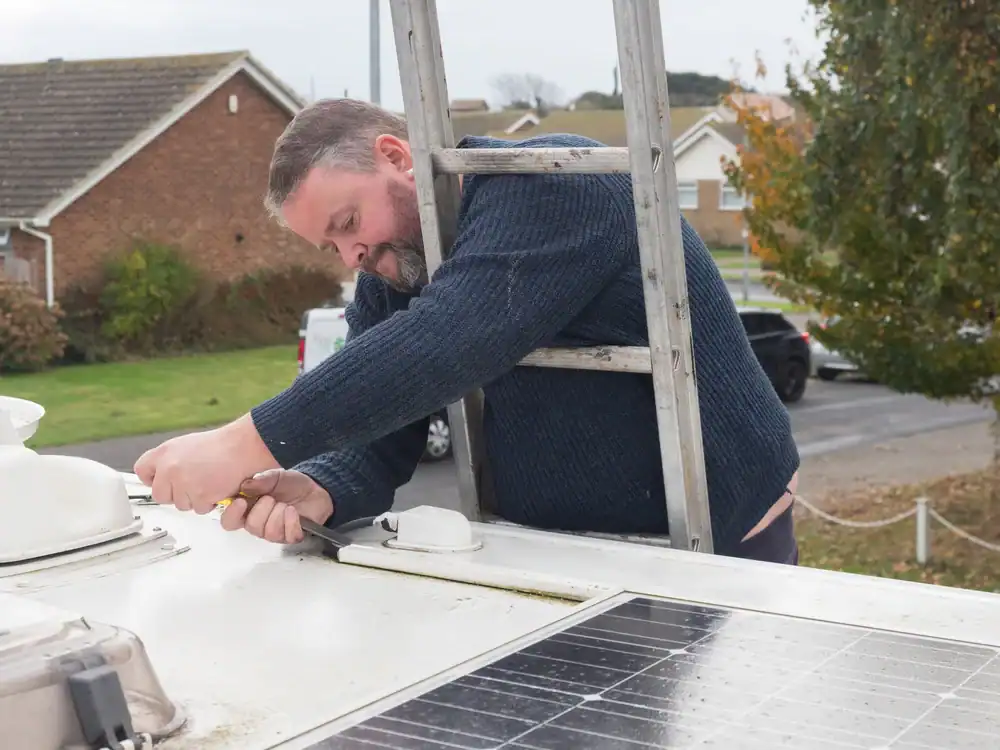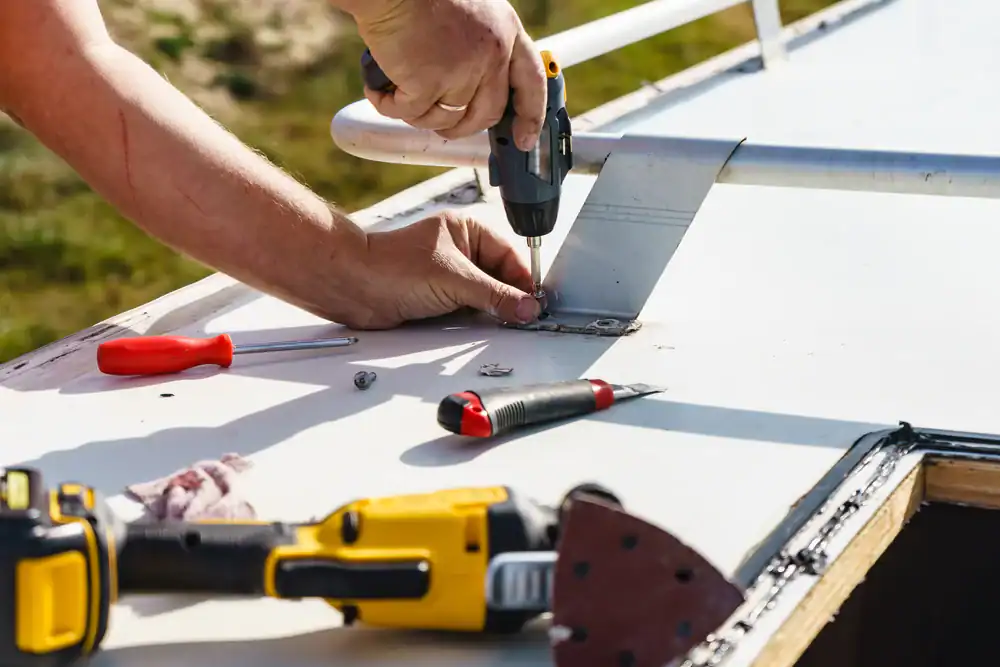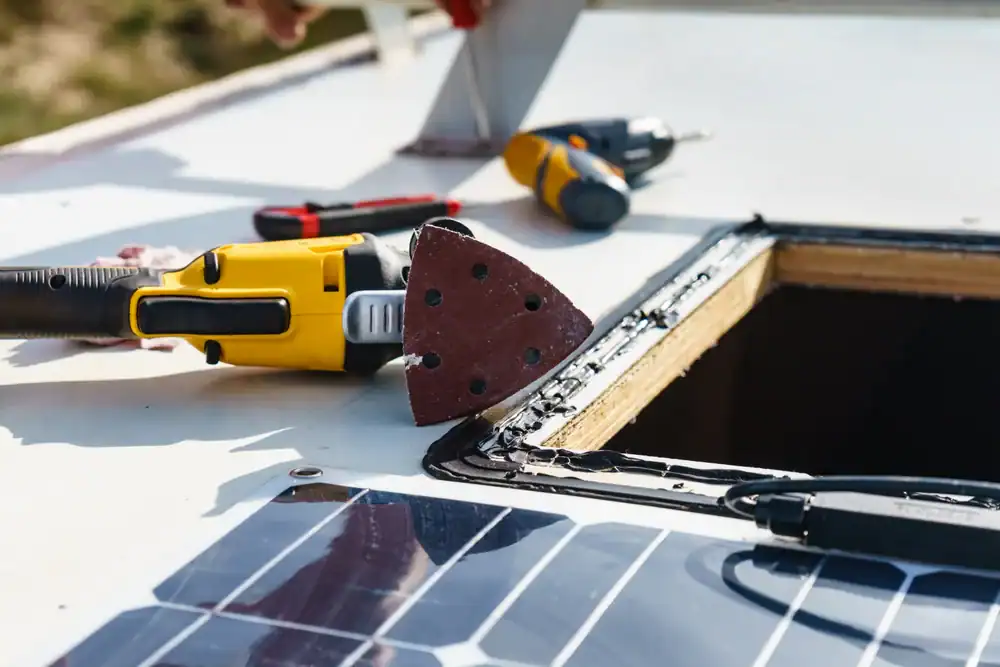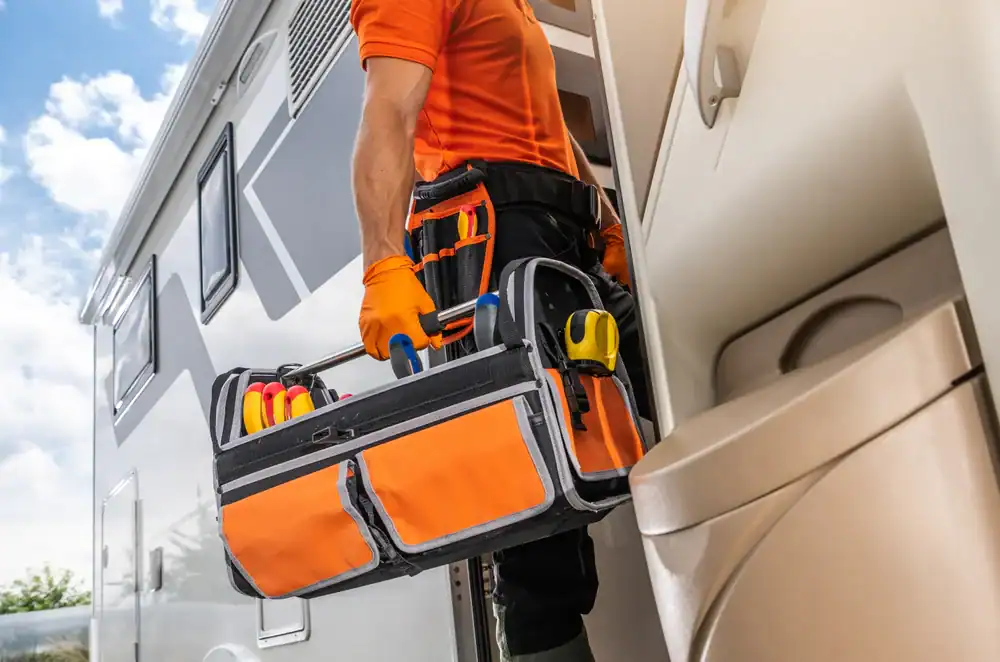Summary:
How to Identify Your RV Roof Material
Before you can properly maintain or repair your roof, you need to know what you’re dealing with. Most RV owners assume they know their roof type, but many get it wrong.
The easiest way to tell is by touch and appearance. Walk up to your roof and take a close look. Each material has distinct characteristics that make identification straightforward once you know what to look for.
Rubber EPDM Roofs: The Flexible Workhorse
Rubber EPDM roofs feel exactly like you’d expect – rubbery and flexible. When you walk on one, it has a slight give under your feet. The surface is typically black or white and has a matte finish that doesn’t reflect much light.
These roofs are made from a single membrane that’s either fully adhered or mechanically fastened to the roof deck. You’ll often see the seams where pieces join together, and these seams are sealed with special EPDM tape or liquid sealant.
EPDM has been the go-to choice for RV manufacturers for decades because it’s relatively inexpensive and handles temperature changes well. It expands and contracts without cracking, which is crucial when your RV sits in varying climates. The downside is that it’s more susceptible to punctures and tears than harder materials.
When it comes to RV roof repair on rubber surfaces, you’re usually dealing with seam failures, punctures from branches, or general wear around roof penetrations like vents and air conditioners. The good news is that rubber roof repairs are typically straightforward and cost-effective when caught early.
Most rubber roofs last 10-15 years with proper maintenance, but that lifespan depends heavily on climate exposure and how well they’re maintained. In North Carolina’s climate, UV exposure and seasonal temperature swings can accelerate aging if the roof isn’t properly treated and inspected regularly.
Fiberglass Roofs: The Hard Shell Option
Rubber EPDM roofs feel exactly like you’d expect – rubbery and flexible. When you walk on one, it has a slight give under your feet. The surface is typically black or white and has a matte finish that doesn’t reflect much light.
These roofs are made from a single membrane that’s either fully adhered or mechanically fastened to the roof deck. You’ll often see the seams where pieces join together, and these seams are sealed with special EPDM tape or liquid sealant.
EPDM has been the go-to choice for RV manufacturers for decades because it’s relatively inexpensive and handles temperature changes well. It expands and contracts without cracking, which is crucial when your RV sits in varying climates. The downside is that it’s more susceptible to punctures and tears than harder materials.
When it comes to RV roof repair on rubber surfaces, you’re usually dealing with seam failures, punctures from branches, or general wear around roof penetrations like vents and air conditioners. The good news is that rubber roof repairs are typically straightforward and cost-effective when caught early.
Most rubber roofs last 10-15 years with proper maintenance, but that lifespan depends heavily on climate exposure and how well they’re maintained. In North Carolina’s climate, UV exposure and seasonal temperature swings can accelerate aging if the roof isn’t properly treated and inspected regularly.
TPO Roofs: The Modern Alternative
TPO (Thermoplastic Polyolefin) is the newest player in RV roofing, and it’s gaining ground fast. It combines some of the best characteristics of both rubber and fiberglass while addressing weaknesses of both.
TPO feels similar to rubber but with a different texture – slightly more rigid than EPDM but still flexible. It’s typically white or light colored and has a semi-gloss finish that’s more reflective than rubber but not as shiny as fiberglass.
TPO Performance and Maintenance Requirements
What sets TPO apart is its resistance to common RV roof problems. It handles UV exposure better than rubber without requiring regular conditioning treatments. It’s more puncture-resistant than EPDM but more flexible than fiberglass, giving you a middle ground that works well in varying conditions.
TPO roofs are heat-welded at the seams, creating bonds that are actually stronger than the material itself. This eliminates the seam failures that plague many rubber roofs over time. When properly installed, TPO seams should never be a maintenance concern.
The material also resists common RV roof enemies like tree sap, bird droppings, and chemical exposure from air pollution. While these substances can stain and degrade rubber roofs, TPO typically cleans up without permanent damage.
Maintenance is straightforward – regular cleaning and inspection, with particular attention to areas around roof penetrations where sealants interface with the TPO membrane. Unlike rubber roofs that need conditioning treatments, TPO maintains its flexibility and weather resistance without additional chemical treatments.
When TPO roofs do need repair, it’s usually related to installation issues or damage from external forces rather than material degradation. Proper TPO repair requires heat welding equipment and specific techniques, making it more of a professional job than typical rubber roof patches.
The main downside to TPO is cost – both initial installation and repairs tend to be more expensive than rubber alternatives. However, the longer lifespan and reduced maintenance requirements often offset the higher upfront investment.
Which Roof Type Needs the Most Maintenance?
Rubber EPDM roofs require the most ongoing maintenance, but that doesn’t necessarily make them the worst choice. They need regular cleaning, periodic conditioning treatments to prevent cracking, and careful attention to seam integrity. Most experts recommend treating rubber roofs every 3-4 months in climates like North Carolina.
Fiberglass requires the least frequent maintenance but demands more attention when maintenance is needed. Annual cleaning and waxing keeps the gel coat healthy, and seam inspection is crucial since repairs are more complex when problems develop.
TPO falls in the middle for maintenance frequency but requires the least specialized care. Regular cleaning and inspection are usually sufficient, with professional attention needed mainly for repairs rather than preventive treatments.
The reality is that all three roof types will serve you well if maintained properly. The key is understanding what your specific roof needs and staying ahead of problems rather than reacting to them. In Durham County’s climate, this means paying extra attention during spring and fall when temperature swings are most dramatic.
Your maintenance schedule should also account for how you use your RV. Full-time travelers need more frequent inspections than weekend campers, and RVs stored under trees need different care than those kept in open storage.
Choosing the Right Approach for Your RV Roof
Understanding your roof material is the foundation of proper RV maintenance. Whether you’re dealing with rubber’s flexibility, fiberglass’s durability, or TPO’s modern advantages, each material has specific needs that affect both routine care and repair decisions.
The most expensive roof problems happen when small issues get ignored or treated incorrectly. Knowing your material type helps you spot problems early and address them appropriately before they become major headaches.
When you need professional RV roof repair or maintenance in Durham County, we at Stream RV understand the specific challenges each roof type presents and can help you make informed decisions about repair versus replacement based on your roof’s actual condition and your travel plans.





